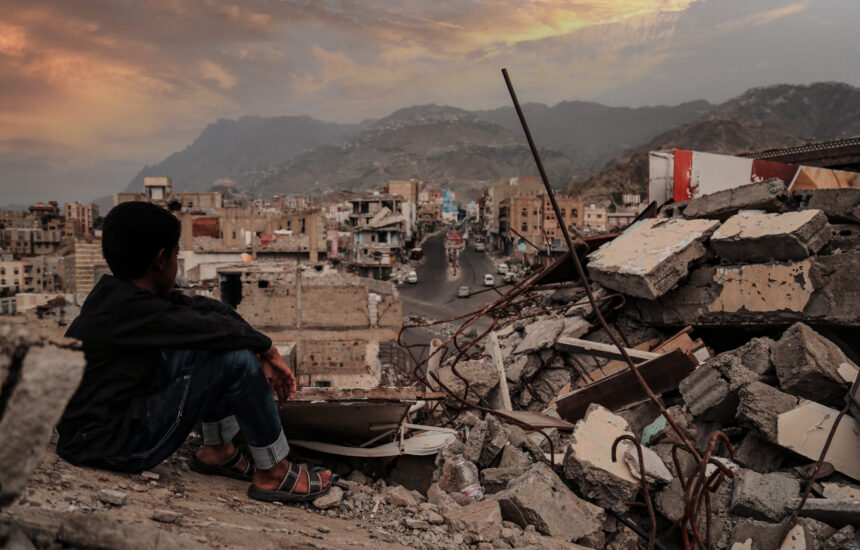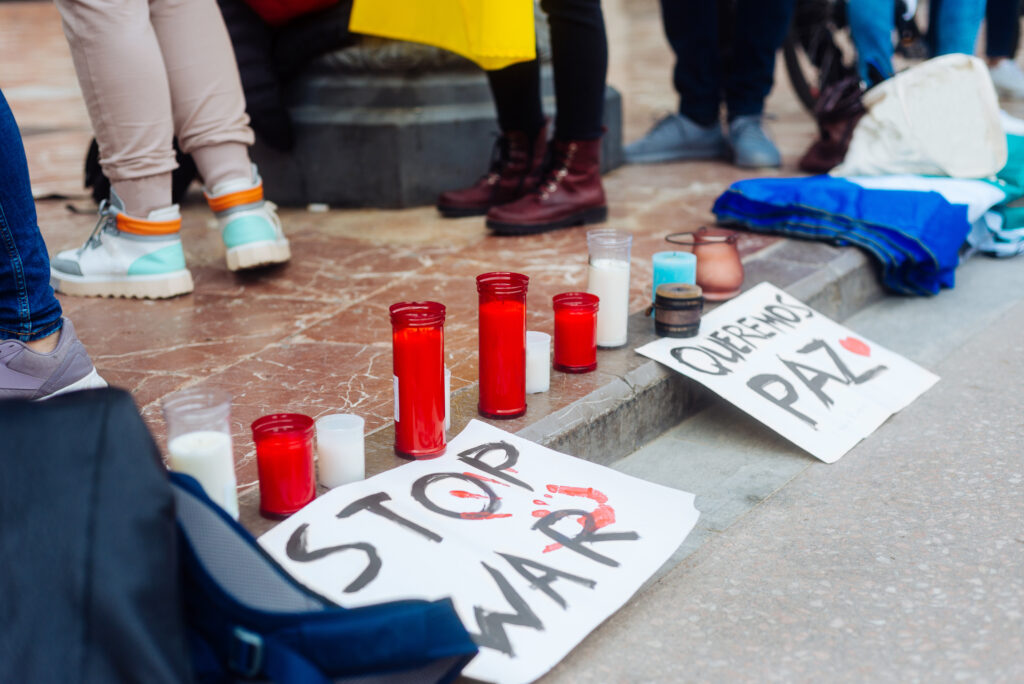Our Humanity at Risk: Statement on War and the Vulnerability of Children


Throughout human history, children have suffered the consequences of decisions made by adults, particularly during war and conflict. Today — despite international conventions and agreements — children continue to be killed and harmed by war and conflict. This is not acceptable, and we must work together to find solutions to build a peaceful world.
Throughout much of human history, the killing of children during conflict has been considered the ultimate tragedy, but it wasn’t until the 20th century that significant attention was paid to the rights of children and specifically to their right to protection during times of war and conflict.
The establishment of the United Nations in 1945, after World War II, ushered in a new era of universal agreements concerning children and their protection. Agreements such as the Geneva Conventions (1949) provided, and still provide, general protection for civilians, especially women and children, during armed conflict. The conventions emphasize humane treatment and the protection of children from the effects of war, particularly children younger than 15 years of age.
The development of international humanitarian law has been a critical step in the evolution of our humanity — our ability to recognize the value of human life, particularly our young. As humans, we generally like to believe that we have evolved far beyond the primal instinct to kill as a solution to our problems. Yet war and armed conflict continue and, without doubt, demonstrate a disregard of human life as people seek to solve disagreements through violent attacks. Such instincts, when allowed free rein, do not consider who is being killed. Tragically, civilians are being killed, some of whom are the most fragile and vulnerable — children, the elderly, and persons with disabilities. Human rights and humanitarian needs are disregarded.
Even with humanitarian agreements in place about acceptable actions during times of war, the harm done to children in conflict zones has been intensifying. UNICEF reports that 2024 was one of the worst years in history for children being killed, injured, or critically malnourished during armed conflicts.
It seems that in many modern conflicts, civilians have actually been targeted, including children. Estimates suggest that millions of children were killed in wars during the 20th century, and this trend continues to rise.
Of those children who are not killed, millions are left orphaned, starving, injured, maimed, traumatized, and/or displaced. Today, in the 21st century, we are still witnessing increased attacks that disregard the protection of children and leave them suffering.
When we were less globally connected to instant news from around the world, we did not know as much about tragic acts against children. What we did know usually came to us after the horrors were long over.
Today, it is different. Being globally connected means that it no longer takes weeks, months, or years to learn of a tragedy that has killed hundreds or even thousands of children. We know what is happening to children, almost in real time.
In today’s world, we feel the impact of war and violence even when it may be thousands of miles away. We can no longer say that we didn’t know what is happening. Six billion people on earth have cell phones and, of that number, almost five billion have phones that provide instant access to news reports. We not only know when children are dying, but also know where.
From Gaza to Myanmar, Haiti to Sudan, Ukraine to Syria, throughout the Sahel region of Africa, and in so many other places, the world is experiencing the highest number of conflicts since World War II.
Almost 19% of the world’s children now live in conflict zones — nearly 1 in 5 globally. There are currently almost 50 armed conflicts impacting the lives of children, and the death tolls of children who are trapped in war and conflict zones are increasing year after year. There are often no open routes available to allow for children’s removal to safer places or to establish “no go zones” where children can be taken for shelter, food, and care.
Are children’s deaths being dismissed by leaders as justifiable collateral damage when warring parties cannot agree? Do they consider it acceptable to say children were just “in the wrong place at the wrong time,” born into a city or country ravaged by war?

World leaders continue their disagreements and draw out their negotiations day after day, week after week, while children suffer and cling to life. Although it is easier to turn away from the suffering, we must understand that children’s little hearts bravely continue to beat while their bodies are injured or torn apart by violent attacks or when starvation gradually sets in and they are reduced to feeble, hollow shells of their former selves. The children who do manage to survive are most likely traumatized for life. Seeing a child traumatized by war — with hollow, wide eyes, shaking and jumping at every little sound — is a chilling experience.
So many of us are bewildered by the acts that individuals and nations commit, and we call for peaceful ways to resolve our differences. However, many world leaders and others with the authority and power to prevent or stop harm to children are not taking adequate steps to protect children.
We all — including world leaders — have a responsibility to help our world find better ways to resolve conflicts and to encourage and support leaders who do understand that war is a scar on the soul of any nation. Direct and systematic attacks on children are an assault on our humanity. World leaders need to hear our concerns if they are to be influenced by our opposition to a war as a way to resolve conflicts.
Wars never solve problems; in fact, they create more problems, leading to long-term damage to both victims and aggressors that cannot be easily erased.
People who are attacked either die or are traumatized for life. The aggressor lives in guilt that is passed on from generation to generation and must deal with a blemished history of violence and brutality. Children of the aggressor are often tainted for life by feelings of remorse or blame for a war they had no part in.
Neither side wins. In the end, war is a “zero-sum game.”
 What’s Next for Humanity?
What’s Next for Humanity?It is urgent that we call for a new era of human consciousness that truly understands how our interconnected world is hurting and crying out for humanity to recognize its power to create peaceful solutions.
At Childhood Education International, we are interconnected with leaders and practitioners in education, health, and child protection around the world who care deeply about children’s safety and wellbeing. We hear their concerns and frustrations about the terrible harm being done to all children in war and conflict zones. As the host of the Early Childhood Development Task Force (ECDtf), which focuses on the rights and wellbeing of children with disabilities, we are also extremely aware of the serious concern about the care and services, or lack thereof, being provided to children with disabilities through community clinics, schools, and hospitals, as during war many of these close or are demolished by attacks. The special care children with disabilities receive is absolutely critical to their wellbeing, and, in some cases, to their ability to stay alive. Every day, we hear the outcry from our community about the need for nations to prioritize child protection, including during times of war and conflict.
The elimination of war as way to resolve human disagreements is urgent, but almost as urgent is the introduction of peace education programs that hold promise for building a better future. Such programs teach children at early ages how to reach agreement and find peaceful ways to resolve disagreements and conflicts together. We desperately need schools and communities to invest in these programs. When children and adults learn positive ways to resolve conflicts — without acts of violence — we have a better hope for a future where our humanity flourishes, where the intergenerational trauma of violence is disrupted, and where the next generation of children can grow up free from the horrors of war.
We now have an enormous responsibility as a human community to choose between war and peace. Either we can continue to propagate hate, violence, and war, or we can find a new path forward with reasonable solutions to conflicts that lead to better understanding between all people.
Let’s all come together to find better ways to contribute to a more peaceful and sustainable world and let’s call on world leaders to choose peace and to find alternatives to violence for resolving conflicts. Our children are counting on us, and our humanity is at risk.
 Diane Whitehead, President & CEO
Diane Whitehead, President & CEODiane Whitehead has dedicated her career to issues that affect the lives of children and families. She specializes in global education, children’s education and learning, the human right to education, nonprofit leadership, management, strategic direction-setting, and program development.
Through her strategic guidance and management of this 130+year-old organization, Diane has expanded its global reach, built partnerships with education-focused organizations around the world, designed impactful programs, and participated in key international education forums and United Nations’ initiatives, a recognition of her commitment to transforming education. As Chief Executive Officer, she is dedicated to building CE International’s relevancy, reach, and impact.
Diane is the creator of Education Diplomacy and co-author of the Education Diplomacy Professional Standards. She also co-authored the International Principles of Practice for Educators to guide and inspire practitioners and to elevate the education profession by highlighting the incredible service that educators provide to both international and human development. Both Education Diplomacy and the International Principles of Practice are forging new pathways for the professional development of educators.
Diane is available to speak on education topics, leadership, change management, and the future of humanity. If you would like to invite Diane for a speaker engagement at a conference or event, please contact Kacy Kostiuk, Director of Communications, at kkostiuk@ceinternational1892.org.